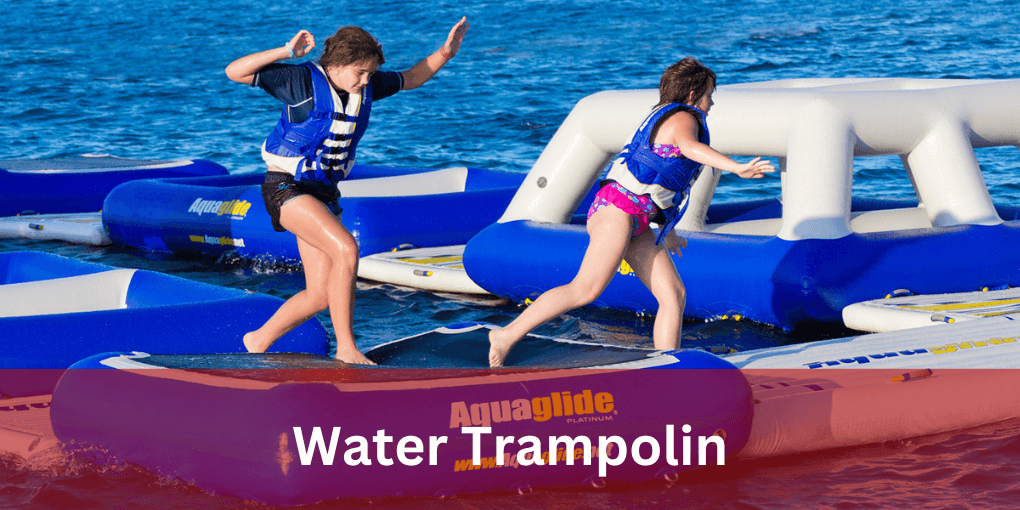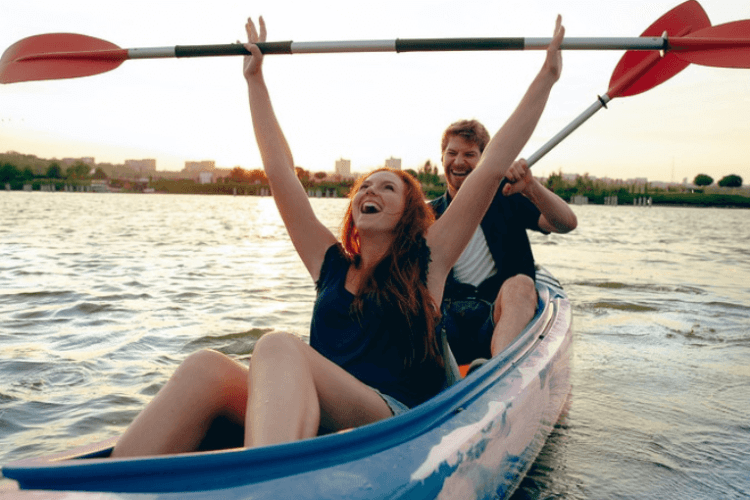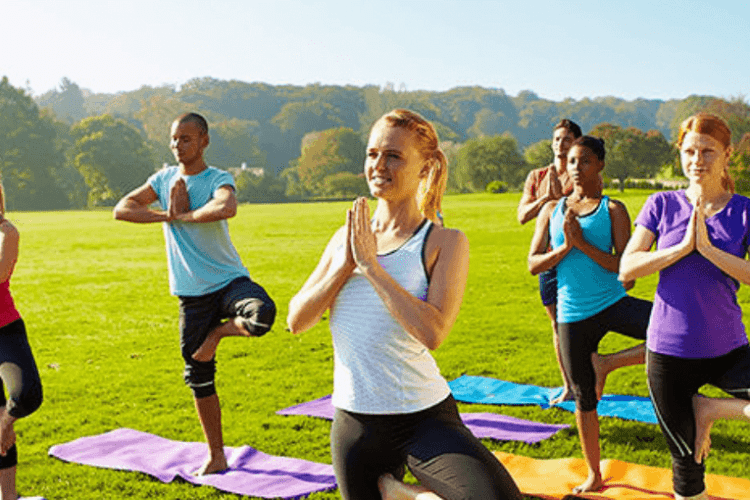Water Trampoline: The Perfect Addition to Your Lake House
A water trampoline is a popular inflatable water toy that provides endless fun and entertainment for people of all ages.

It’s a great way to enjoy the summer season, whether you’re spending time at the beach, lake, or pool.
In this blog post, I’ll explore the different types of water trampoline, their advantages, and their disadvantages.
You also learn different types of tips for setting them up and maintaining them.
I’ll also discuss safety tips for using these trampolines and share my (Mr. Reko’s) real-life experiences.
Definition of the water trampoline
According to Wikipedia, A water trampoline is an inflatable, buoyant structure that sits on the surface of the water, allowing users to jump, bounce, and play on its surface.
It is made up of a jumping surface that is supported by a series of inflated tubes or springs.
It can come in various sizes and shapes, ranging from small single-person bouncers to large multi-person trampolines.
The jumping surface is typically made of durable materials such as PVC or reinforced nylon. It may also include safety features such as padding, handles, and safety nets.
Water trampolines are a popular summer toy. It provides hours of entertainment for families and friends and is often used in lakes, pools, and other bodies of water.
Advantages of Water Trampolines
It offer numerous advantages, making them a popular summer activity for many people. Here are some of the advantages:
Fun and Entertainment
They provide hours of fun and entertainment for people of all ages.
They offer a unique way to enjoy the water, combining the thrill of jumping and bouncing with the refreshing feeling of being in the water.
Health Benefits
They are a low-impact activity that can improve cardiovascular health, muscle strength, balance, and coordination. Jumping and bouncing on a trampoline is also a great way to burn calories.
Socializing and Bonding
They also provide an opportunity for families and friends to come together and have fun in the sun.
They are a great way to socialize and bond with others, creating lasting memories and moments of joy.
Versatility
It comes in a variety of sizes and shapes, and can be used in lakes, pools, and other bodies of water.
They can also be used for a variety of activities, including jumping, bouncing, playing games, and relaxing.
Types of Water Trampolines
It comes in different types, shapes, and sizes. Here are some of the most common types:
Round Water Trampolines
These are the most common type of trampolines, and they come in a variety of sizes ranging from 10 to 20 feet in diameter.
They are designed for single or double jumpers and are great for jumping and bouncing.
Square Water Trampolines
These are similar to round trampolines, but they have a square shape. They offer more jumping space than round water trampolines. They can accommodate multiple jumpers.
Rectangular Water Trampolines
These are the largest types of trampoline and are designed for multiple jumpers.
They offer more space and are ideal for jumping, playing games, and lounging.
Water Bouncers
These are smaller and less expensive than those trampolines and are designed for single or double jumpers. They are great for jumping and bouncing and can be used in smaller bodies of water.
Inflatable Water Parks
These are larger inflatable structures that include multiple trampoline, slides, and other water features. They offer a variety of activities and are ideal for larger groups and parties.
How to Set Up and Maintain Water Trampolines
Setting up and maintaining a trampoline requires some effort, but it is relatively straightforward. Here are some tips for setting up and maintaining:
Choose a Suitable Location
Select a location with a calm and safe body of water, free of rocks, branches, or other sharp objects that could puncture the trampoline.
Inflate the Trampoline
Using a pump, inflate the trampoline and ensure that it is firm and inflated.
Secure the Trampoline
Once inflated, secure the trampoline to the ground or anchor it to the lake bottom using ropes. It can prevent from drifting away or flipping over.
Install Safety Features
Install safety features such as padding, handles, and safety nets to prevent injury.
Regular Maintenance
Regularly inspect the trampoline for punctures or leaks, and patch any holes as needed. Keep the trampoline clean and dry, and store it in a cool, dry place when not in use.
Check Local Regulations
Before setting up a this, check local regulations. You need to obtain any necessary permits to ensure compliance with safety and environmental laws.
Safety Tips for Water Trampolines
It can provide hours of fun and entertainment, but they can also be dangerous if not used properly.
- If you are not a strong swimmer, always wear a life jacket or personal flotation device (PFD) when using this.
- Never jump or dive headfirst into the water from a water trampoline, as this can result in serious injury.
- Always jump or bounce one person at a time to prevent collisions and injuries.
- Do not exceed the recommended weight limit, as this can cause the trampoline to tip over or deflate.
- Avoid using a the trampoline during inclement weather, such as high winds, thunderstorms, or heavy rain.
- Make sure the trampoline is properly anchored to the ground or lake bottom to prevent it from drifting away or flipping over.
- Keep a watchful eye on children and inexperienced swimmers when using it.
- Always follow the manufacturer’s instructions for setting up.
Buying a Water Trampoline
If you are considering buying a water trampoline, there are several factors to consider. Here are some tips to help you make an informed buying decision:
Size
Consider the size based on the available space in your lake or pond and the number of people you want to accommodate. Larger trampolines can accommodate more people but may require more space.
Type
Choose the type that best suits your needs, whether it’s a round, square, rectangular, or inflatable water park.
Material
Look for a water trampoline made from high-quality materials such as PVC, nylon, or polyurethane. They are durable and resistant to punctures and UV damage.
Weight Limit
Consider the weight limit of the trampoline, and ensure that it can safely support the number of people who will be using it.
Safety Features
Look for a this with safety features such as padding, handles, and safety nets to prevent injury.
Price
Set a budget for the purchase, and compare prices from different retailers to find the best value for your money.
Reviews
Read reviews from other customers who have purchased the trampoline. You are considering getting an idea of its quality and performance.
Tips for Storing Water Trampolines
Properly storing your water trampoline when it is not in use can help prolong its life and prevent damage. Here are some tips:
- Before storing your trampoline, make sure it is completely dry and free of debris.
- Disassemble your trampoline according to the manufacturer’s instructions.
- If possible, store it indoors in a cool, dry place to prevent it from being damaged by sunlight, wind, or moisture.
- If you must store it outdoors, cover it with a protective tarp.
- Secure your trampoline to prevent it from blowing away or being damaged by high winds or storms.
- Regularly inspect the trampoline for signs of wear or damage, and repair any issues promptly to prevent further damage.
Entertainment and recreational aspects
A. Versatility in Fun Activities
Jumping Contests: Organizing friendly jumping competitions among family and friends.
Trick Shows: Showcasing acrobatic moves and tricks, adding an element of excitement.
B. Inclusive Fun for All Ages
Children’s Play: Creating a safe and enjoyable space for kids to bounce and play.
Teenage Thrills: Adventure and excitement for teenagers, fostering a sense of adventure.
C. Group Activities and Games
Water Volleyball: Transforming the trampoline into a makeshift volleyball court for spirited matches.
Tag or Catch: Playing classic games with a watery twist, making it a unique experience.
D. Social Bonding
Family Time: Providing a shared space for families to bond over laughter and shared activities.
Friendship Building: Enhancing camaraderie among friends through collaborative games.
E. Relaxation and Leisure
Lounging: Using the trampoline as a floating lounge for sunbathing or stargazing.
Waterfront Seating: Enjoy a unique seating arrangement while being surrounded by water.
F. Seasonal Celebrations
Summer Parties: Make water trampolines a centerpiece for summer gatherings and celebrations.
Holiday Splash: Incorporating the trampoline into holiday festivities for a memorable experience.
G. Adventure and Exploration
Diving Platform: Using the trampoline as a platform for diving into the water, adding an adventurous dimension.
Obstacle Courses: Setting up challenging obstacle courses for an extra thrill.
H. Photography and Documentation
Capture the Moment: Providing unique photo opportunities for documenting memorable experiences.
Social Media Appeal: Leveraging the visual appeal of the trampolines for social media sharing.
I. Educational Engagement
Environmental Exploration: Encouraging interest in aquatic life by observing the water beneath.
Physics of Bouncing: Educational activities explaining the science behind the trampoline’s buoyancy.
Environmental Impact of Water Trampolines

While water trampolines can provide hours of fun and entertainment, they can also have a negative impact on the environment.
Noise Pollution: The noise generated by water trampolines can disrupt the natural environment.
Water Quality: It can cause water pollution by introducing chemicals or detergents into the water. It can harm aquatic life and degrade water quality.
Anchor Damage: The anchors used to secure the trampolines can damage the lake or pond bed. It disrupts natural habitats and ecosystems.
Litter: It can contribute to litter in the water if not properly secured or maintained.
To minimize the environmental impact of your trampoline, consider the following tips:
- Use environmentally-friendly cleaning products to clean your trampoline.
- Avoid using detergents or other chemicals that can harm aquatic life.
- Anchor your trampoline in a way that minimizes damage to the lake or pond bed.
- Dispose of any litter or debris properly.
- Consider the size and location of your this trampoline and its impact on the surrounding environment.
Popular Water Trampoline Activities
There are many fun activities that you can do on this trampoline. It can be a popular choice for summer activities.
Jumping
Jumping on a trampoline is one of the most popular activities. It provides hours of fun and entertainment for kids and adults alike.
Flips and Tricks
For the more adventurous, these trampolines are great for practicing flips and other tricks.
Water Basketball
Many water trampolines come with basketball hoops, making it a great activity for groups.
Water Volleyball
It can also be used for playing water volleyball. It also provides a fun and challenging activity for all ages.
Lounge and Relax
It can also be used for relaxing and lounging in the sun. You might be a comfortable and fun place to hang out on the water.
Obstacle Courses
Some trampolines come with inflatable obstacle courses. It provides a pleasant and difficult pastime for both children and adults.
Conclusion
They provides a fun and exciting way to enjoy the water during the summer months.
They provide fitness, balance, coordination, and hours of fun for youngsters and adults.
Following safety guidelines and maintaining your water trampoline will ensure it lasts for years and gives you hours of fun in the sun.
If you want to try something different this summer, buy a water trampoline.
FAQs
A water trampoline is like a bouncy, floating playground on the water! It's an inflatable trampoline that you can jump on while floating in a lake, pond, or pool.
The water trampoline has air inside that makes it float. It also has special ropes and anchors to keep it in one place so you can jump safely.
Absolutely! Water trampolines are super fun to use with friends. You can have jumping contests, play games, and even do tricks together.
The water should be deep enough so you can jump without touching the bottom. Ask a grown-up to make sure the water is safe for jumping.


